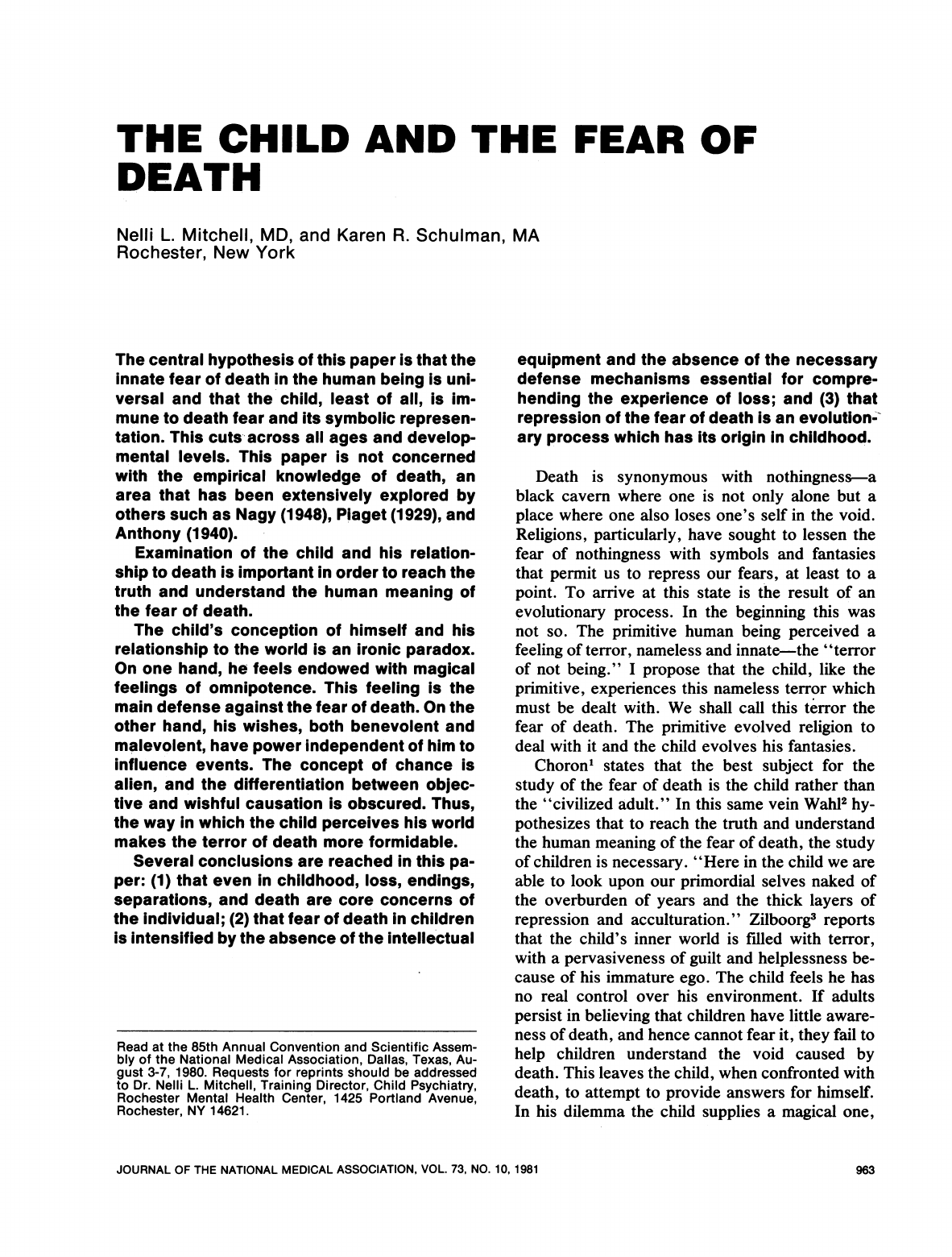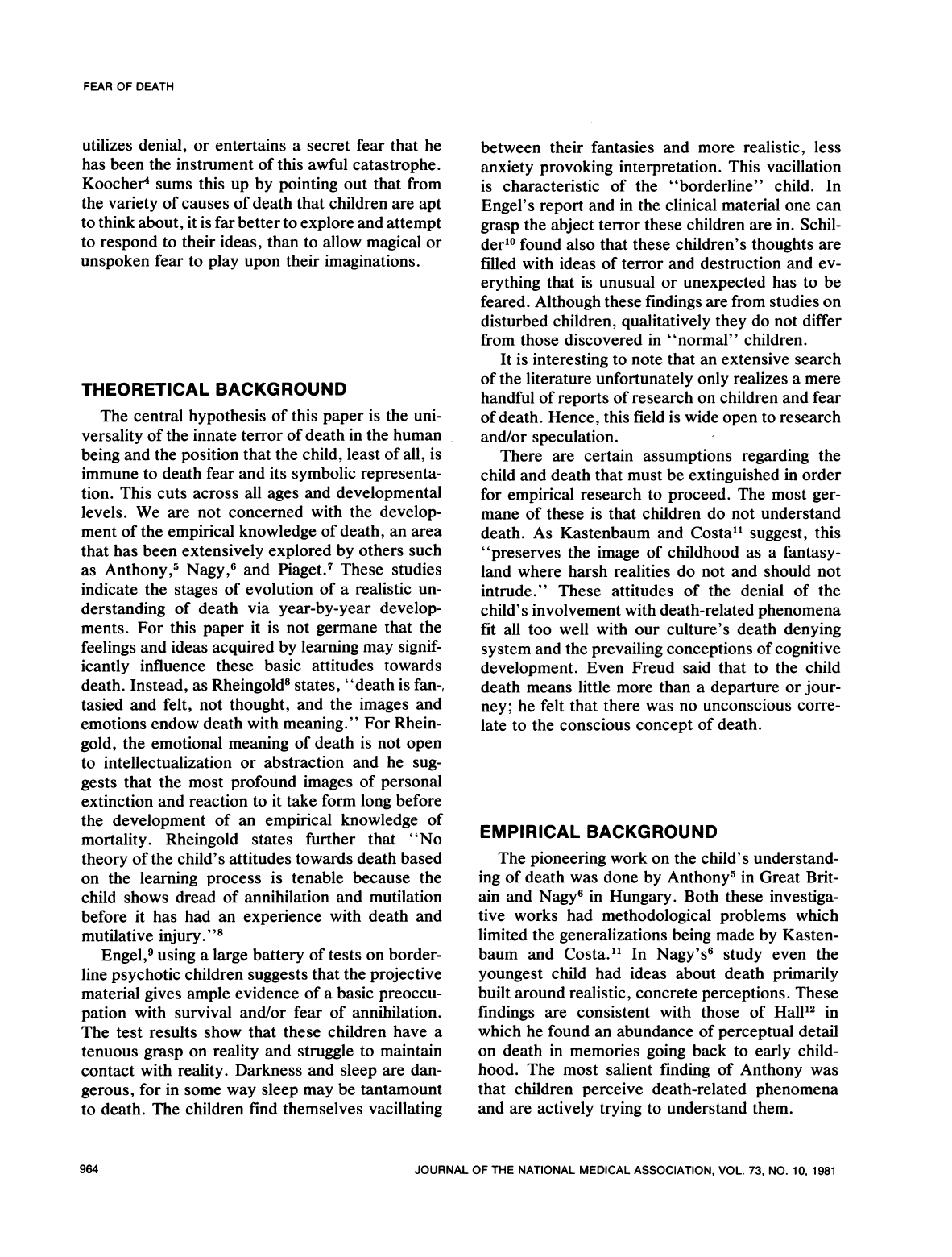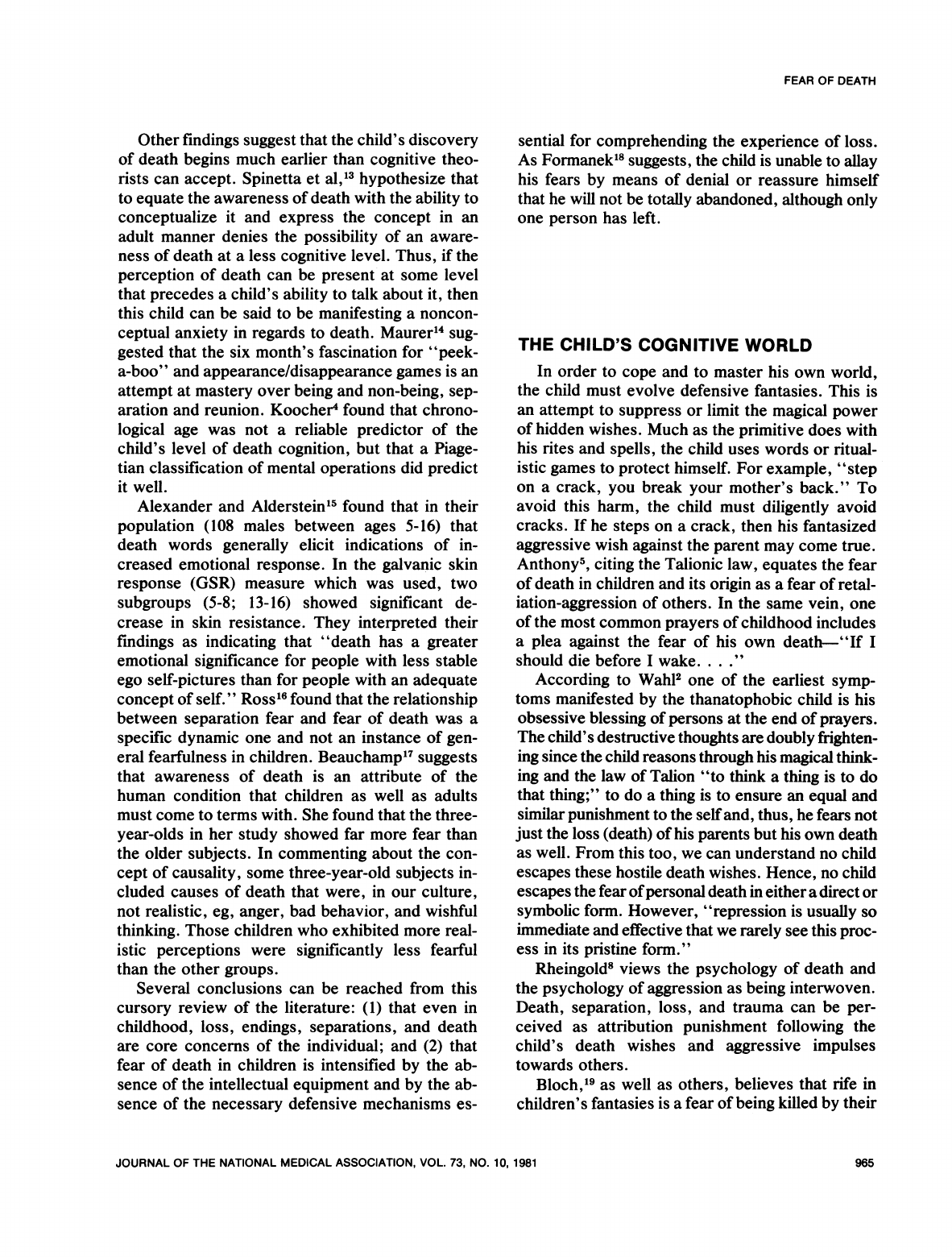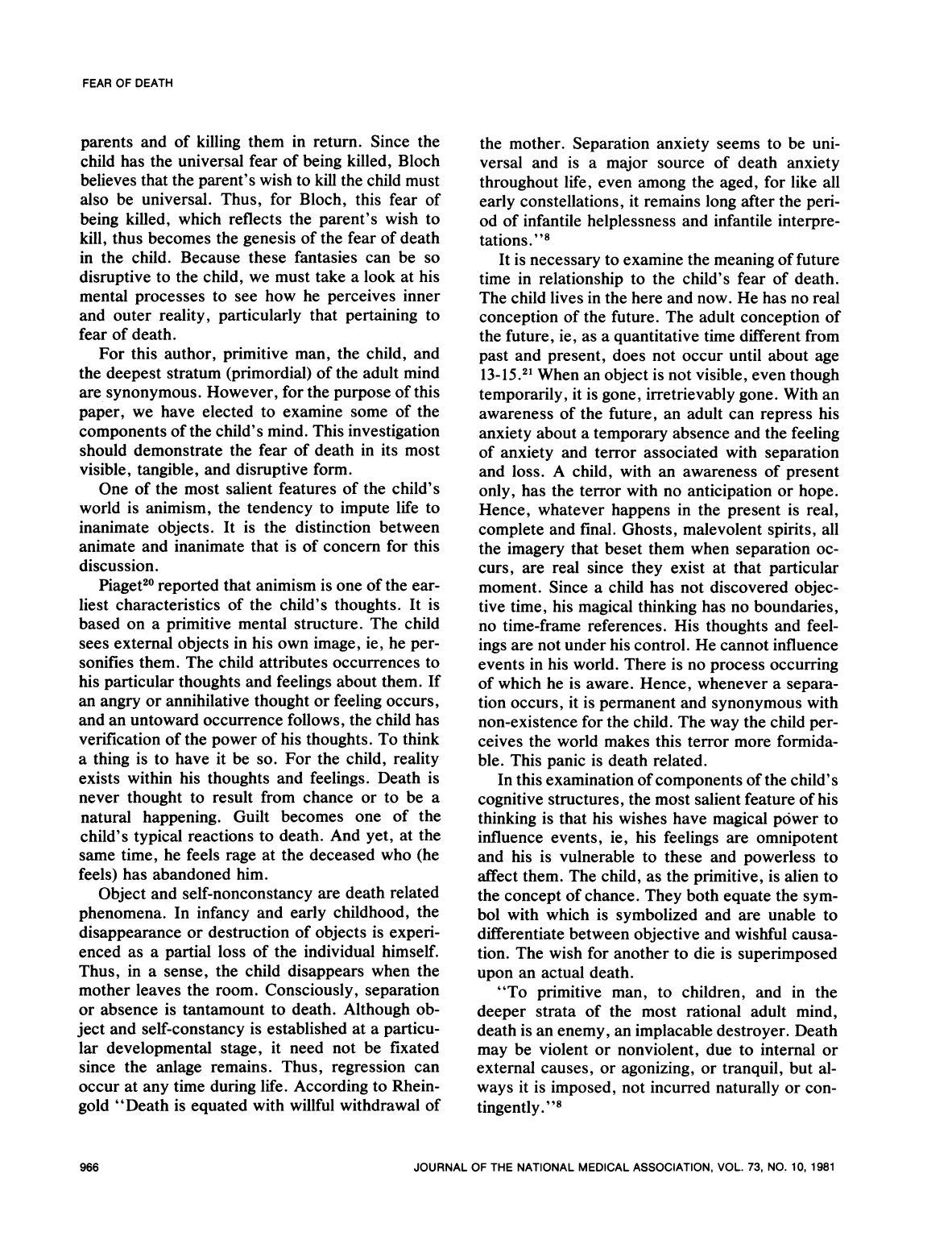
THE
CHILD
AND
THE
FEAR
F1
DEATH
Nelli
L.
Mitchell,
MD,
and
Karen
R.
Schulman,
MA
Rochester,
New
York
The
central
hypothesis
of
this
paper
is
that
the
innate
fear
of
death
in
the
human
being
is
uni-
versal
and
that
the
child,
least
of
all,
is
im-
mune
to
death
fear
and
its
symbolic
represen-
tation.
This
cuts
across
all
ages and
develop-
mental
levels.
This
paper
is
not
concerned
with
the
empirical
knowledge
of
death,
an
area
that
has
been
extensively
explored
by
others
such
as
Nagy
(1948),
Piaget
(1929),
and
Anthony
(1940).
Examination
of
the
child
and
his
relation-
ship
to
death
is
important
in
order
to
reach
the
truth
and
understand
the
human
meaning
of
the
fear
of
death.
The
child's
conception
of
himself
and
his
relationship
to
the
world
is
an
ironic
paradox.
On
one
hand,
he
feels
endowed
with
magical
feelings
of
omnipotence.
This
feeling
is
the
main
defense
against
the
fear
of
death.
On
the
other
hand,
his
wishes,
both
benevolent
and
malevolent,
have
power
independent
of
him
to
influence
events.
The
concept
of
chance
is
alien,
and
the
differentiation
between
objec-
tive
and
wishful
causation
is
obscured.
Thus,
the
way
in
which
the
child
perceives
his
world
makes
the
terror
of
death
more
formidable.
Several
conclusions
are
reached
in
this
pa-
per:
(1)
that
even
in
childhood,
loss,
endings,
separations,
and
death
are
core
concerns
of
the
individual;
(2)
that
fear
of
death
in
children
is
intensified
by
the
absence
of
the
intellectual
Read
at
the
85th
Annual
Convention
and
Scientific
Assem-
bly
of
the
National
Medical
Association,
Dallas,
Texas,
Au-
gust
3-7,
1980.
Requests
for
reprints
should
be
addressed
to
Dr.
Nelli
L.
Mitchell,
Training
Director,
Child
Psychiatry,
Rochester
Mental
Health
Center,
1425
Portland
Avenue,
Rochester,
NY
14621.
equipment
and
the
absence
of
the
necessary
defense
mechanisms
essential
for
compre-
hending
the
experience
of
loss;
and
(3)
that
repression
of
the
fear
of
death
is
an
evolution--
ary
process
which
has
its
origin
in
childhood.
Death
is
synonymous
with
nothingness-a
black
cavern
where
one
is
not
only
alone
but
a
place
where
one
also
loses
one's
self
in
the
void.
Religions,
particularly,
have
sought
to
lessen
the
fear
of
nothingness
with
symbols
and
fantasies
that
permit
us
to
repress
our
fears,
at
least
to
a
point.
To
arrive
at
this
state
is
the
result
of
an
evolutionary
process.
In
the
beginning
this
was
not
so.
The
primitive
human
being
perceived
a
feeling
of
terror,
nameless
and
innate-the
"terror
of
not
being."
I
propose
that
the
child,
like
the
primitive,
experiences
this
nameless
terror
which
must
be
dealt
with.
We
shall
call
this
terror
the
fear
of
death.
The
primitive
evolved
religion
to
deal
with
it
and
the
child
evolves
his
fantasies.
Choron'
states
that
the
best
subject
for
the
study
of
the
fear
of
death
is
the
child
rather
than
the
"civilized
adult."
In
this
same
vein
Wahl2
hy-
pothesizes
that
to
reach
the
truth
and
understand
the
human
meaning
of
the
fear
of
death,
the
study
of
children
is
necessary.
"Here
in
the
child
we
are
able
to
look
upon
our
primordial
selves
naked
of
the
overburden
of
years
and
the
thick
layers
of
repression
and
acculturation."
Zilboorg3
reports
that
the
child's
inner
world
is
filled
with
terror,
with
a
pervasiveness
of
guilt
and
helplessness
be-
cause
of
his
immature
ego.
The
child
feels
he
has
no
real
control
over
his
environment.
If
adults
persist
in
believing
that
children
have
little
aware-
ness
of
death,
and
hence
cannot
fear
it,
they
fail
to
help
children
understand
the
void
caused
by
death.
This
leaves
the
child,
when
confronted
with
death,
to
attempt
to
provide
answers
for
himself.
In
his
dilemma
the
child
supplies
a
magical
one,
JOURNAL
OF
THE
NATIONAL
MEDICAL
ASSOCIATION,
VOL.
73,
NO.
10,
1981
963

FEAR
OF
DEATH
utilizes
denial,
or
entertains
a
secret
fear
that
he
has
been
the
instrument
of
this
awful
catastrophe.
Koocher4
sums
this
up by
pointing
out
that
from
the
variety
of
causes
of
death
that
children
are
apt
to
think
about,
it
is
far
better
to
explore
and
attempt
to
respond
to
their
ideas,
than
to
allow
magical
or
unspoken
fear
to
play
upon
their
imaginations.
THEORETICAL
BACKGROUND
The
central
hypothesis
of
this
paper
is
the
uni-
versality
of
the
innate
terror
of
death
in
the
human
being
and
the
position
that
the
child,
least
of
all,
is
immune
to
death
fear
and
its
symbolic
representa-
tion.
This
cuts
across
all
ages
and
developmental
levels.
We
are
not
concerned
with
the
develop-
ment
of
the
empirical
knowledge
of
death,
an
area
that
has
been
extensively
explored
by
others
such
as
Anthony,5
Nagy,6
and
Piaget.7
These
studies
indicate
the
stages
of
evolution
of
a
realistic
un-
derstanding
of
death
via
year-by-year
develop-
ments.
For
this
paper
it
is
not
germane
that
the
feelings
and
ideas
acquired
by
learning
may
signif-
icantly
influence
these
basic
attitudes
towards
death.
Instead,
as
Rheingold8
states,
"death
is
fan-,
tasied
and
felt,
not
thought,
and
the
images
and
emotions
endow
death
with
meaning."
For
Rhein-
gold,
the
emotional
meaning
of
death
is
not
open
to
intellectualization
or
abstraction
and
he
sug-
gests
that
the
most
profound
images
of
personal
extinction
and
reaction
to
it
take
form
long
before
the
development
of
an
empirical
knowledge
of
mortality.
Rheingold
states
further
that
"No
theory
of
the
child's
attitudes
towards
death
based
on
the
learning
process
is
tenable
because
the
child
shows
dread
of
annihilation
and
mutilation
before
it
has
had
an
experience
with
death
and
mutilative
injury.'
'8
Engel,9
using
a
large
battery
of
tests
on
border-
line
psychotic
children
suggests
that
the
projective
material
gives
ample
evidence
of
a
basic
preoccu-
pation
with
survival
and/or
fear
of
annihilation.
The
test
results
show
that
these
children
have
a
tenuous
grasp
on
reality
and
struggle
to
maintain
contact
with
reality.
Darkness
and
sleep
are
dan-
gerous,
for
in
some
way
sleep
may
be
tantamount
to
death.
The
children
find
themselves
vacillating
between
their
fantasies
and
more
realistic,
less
anxiety
provoking
interpretation.
This
vacillation
is
characteristic
of
the
"borderline"
child.
In
Engel's
report
and
in
the
clinical
material
one
can
grasp
the
abject
terror
these
children
are
in.
Schil-
der'0
found
also
that
these
children's
thoughts
are
filled
with
ideas
of
terror
and
destruction
and
ev-
erything
that
is
unusual
or
unexpected
has
to
be
feared.
Although
these
findings
are
from
studies
on
disturbed
children,
qualitatively
they
do
not
differ
from
those
discovered
in
"normal"
children.
It
is
interesting
to
note
that
an
extensive
search
of
the
literature
unfortunately
only
realizes
a
mere
handful
of
reports
of
research
on
children
and
fear
of
death.
Hence,
this
field
is
wide
open
to
research
and/or
speculation.
There
are
certain
assumptions
regarding
the
child
and
death
that
must
be
extinguished
in
order
for
empirical
research
to
proceed.
The
most
ger-
mane
of
these
is
that
children
do
not
understand
death.
As
Kastenbaum
and
Costa"l
suggest,
this
"preserves
the
image
of
childhood
as
a
fantasy-
land
where
harsh
realities
do
not
and
should
not
intrude."
These
attitudes
of
the
denial
of
the
child's
involvement
with
death-related
phenomena
fit
all
too
well
with
our
culture's
death
denying
system
and
the
prevailing
conceptions
of
cognitive
development.
Even
Freud
said
that
to
the
child
death
means
little
more
than
a
departure
or
jour-
ney;
he
felt
that
there
was
no
unconscious
corre-
late
to
the
conscious
concept
of
death.
EMPIRICAL
BACKGROUND
The
pioneering
work
on
the
child's
understand-
ing
of
death
was
done
by
Anthony5
in
Great
Brit-
ain
and
Nagy6
in
Hungary.
Both
these
investiga-
tive
works
had
methodological
problems
which
limited
the
generalizations
being
made
by
Kasten-
baum
and
Costa."
In
Nagy's6
study
even
the
youngest
child
had
ideas
about
death
primarily
built
around
realistic,
concrete
perceptions.
These
findings
are
consistent
with
those
of
Hall'2
in
which
he
found
an
abundance
of
perceptual
detail
on
death
in
memories
going
back
to
early
child-
hood.
The
most
salient
finding
of
Anthony
was
that
children
perceive
death-related
phenomena
and
are
actively
trying
to
understand
them.
964
JOURNAL
OF
THE
NATIONAL
MEDICAL
ASSOCIATION,
VOL.
73,
NO.
10,
1981

FEAR
OF
DEATH
Other
findings
suggest
that
the
child's
discovery
of
death
begins
much
earlier
than
cognitive
theo-
rists
can
accept.
Spinetta
et
al,13
hypothesize
that
to
equate
the
awareness
ofdeath
with
the
ability
to
conceptualize
it
and
express
the
concept
in
an
adult
manner
denies
the
possibility
of
an
aware-
ness
of
death
at
a
less
cognitive
level.
Thus,
if
the
perception
of
death
can
be
present
at
some
level
that
precedes
a
child's
ability
to
talk
about
it,
then
this
child
can
be
said
to
be
manifesting
a
noncon-
ceptual
anxiety
in
regards
to
death.
Maurer14
sug-
gested
that
the
six
month's
fascination
for
"peek-
a-boo"
and
appearance/disappearance
games
is
an
attempt
at
mastery
over
being
and
non-being,
sep-
aration
and
reunion.
Koocher4
found
that
chrono-
logical
age
was
not
a
reliable
predictor
of
the
child's
level
of
death
cognition,
but
that
a
Piage-
tian
classification
of
mental
operations
did
predict
it
well.
Alexander
and
Alderstein15
found
that
in
their
population
(108
males
between
ages
5-16)
that
death
words
generally
elicit
indications
of
in-
creased
emotional
response.
In
the
galvanic
skin
response
(GSR)
measure
which
was
used,
two
subgroups
(5-8;
13-16)
showed
significant
de-
crease
in
skin
resistance.
They
interpreted
their
findings
as
indicating
that
"death
has
a
greater
emotional
significance
for
people
with
less
stable
ego
self-pictures
than
for
people
with
an
adequate
concept
of
self."
Ross16
found
that
the
relationship
between
separation
fear
and
fear
of
death
was
a
specific
dynamic
one
and
not
an
instance
of
gen-
eral
fearfulness
in
children.
Beauchamp17
suggests
that
awareness
of
death
is
an
attribute
of
the
human
condition
that
children
as
well
as
adults
must
come
to
terms
with.
She
found
that
the
three-
year-olds
in
her
study
showed
far
more
fear
than
the
older
subjects.
In
commenting
about
the
con-
cept
of
causality,
some
three-year-old
subjects
in-
cluded
causes
of
death
that
were,
in
our
culture,
not
realistic,
eg,
anger,
bad
behavior,
and
wishful
thinking.
Those
children
who
exhibited
more
real-
istic
perceptions
were
significantly
less
fearful
than
the
other
groups.
Several
conclusions
can
be
reached
from
this
cursory
review
of
the
literature:
(1)
that
even
in
childhood,
loss,
endings,
separations,
and
death
are
core
concerns
of
the
individual;
and
(2)
that
fear
of
death
in
children
is
intensified
by
the
ab-
sence
of
the
intellectual
equipment
and
by
the
ab-
sence
of
the
necessary
defensive
mechanisms
es-
sential
for
comprehending
the
experience
of
loss.
As
Formanek18
suggests,
the
child
is
unable
to
allay
his
fears
by
means
of
denial
or
reassure
himself
that
he
will
not
be
totally
abandoned,
although
only
one
person
has
left.
THE
CHILD'S
COGNITIVE
WORLD
In
order
to
cope
and
to
master
his
own
world,
the
child
must
evolve
defensive
fantasies.
This
is
an
attempt
to
suppress
or
limit
the
magical
power
of
hidden
wishes.
Much
as
the
primitive
does
with
his
rites
and
spells,
the
child
uses
words
or
ritual-
istic
games
to
protect
himself.
For
example,
"step
on
a
crack,
you
break
your
mother's
back."
To
avoid
this
harm,
the
child
must
diligently
avoid
cracks.
If
he
steps
on
a
crack,
then
his
fantasized
aggressive
wish
against
the
parent
may
come
true.
Anthony5,
citing
the
Talionic
law,
equates
the
fear
of death
in
children
and
its
origin
as
a
fear
of
retal-
iation-aggression
of
others.
In
the
same
vein,
one
of
the
most
common
prayers
of
childhood
includes
a
plea
against
the
fear
of
his
own
death-"If
I
should
die
before
I
wake...
According
to
Wahl2
one
of
the
earliest
symp-
toms
manifested
by
the
thanatophobic
child
is
his
obsessive
blessing
of
persons
at
the
end
of
prayers.
The
child's
destructive
thoughts
are
doubly
frighten-
ing
since
the
child
reasons
through
his
magical
think-
ing
and
the
law
of
Talion
"to
think
a
thing
is
to
do
that
thing;"
to
do
a
thing
is
to
ensure
an
equal
and
similar
punishment
to
the
self
and,
thus,
he
fears
not
just
the
loss
(death)
of
his
parents
but
his
own
death
as
well.
From
this
too,
we
can
understand
no
child
escapes
these
hostile
death
wishes.
Hence,
no
child
escapes
the
fear
of
personal
death
in
either
a
direct
or
symbolic
form.
However,
"repression
is
usually
so
immediate
and
effective
that
we
rarely
see
this
proc-
ess
in
its
pristine
form."
Rheingold8
views
the
psychology
of
death
and
the
psychology
of
aggression
as
being
interwoven.
Death,
separation,
loss,
and
trauma
can
be
per-
ceived
as
attribution
punishment
following
the
child's
death
wishes
and
aggressive
impulses
towards
others.
Bloch,19
as
well
as
others,
believes
that
rife
in
children's
fantasies
is
a
fear
of
being
killed
by
their
JOURNAL
OF
THE
NATIONAL
MEDICAL
ASSOCIATION,
VOL.
73,
NO.
10,
1981
965

FEAR
OF
DEATH
parents
and
of
killing
them
in
return.
Since
the
child
has
the
universal
fear
of
being
killed,
Bloch
believes
that
the
parent's
wish
to
kill
the
child
must
also
be
universal.
Thus,
for
Bloch,
this
fear
of
being
killed,
which
reflects
the
parent's
wish
to
kill,
thus
becomes
the
genesis
of
the
fear
of
death
in
the
child.
Because
these
fantasies
can
be
so
disruptive
to
the
child,
we
must
take
a
look
at
his
mental
processes
to
see
how
he
perceives
inner
and
outer
reality,
particularly
that
pertaining
to
fear
of
death.
For
this
author,
primitive
man,
the
child,
and
the
deepest
stratum
(primordial)
of
the
adult
mind
are
synonymous.
However,
for
the
purpose
of
this
paper,
we
have
elected
to
examine
some
of
the
components
of
the
child's
mind.
This
investigation
should
demonstrate
the
fear
of
death
in
its
most
visible,
tangible,
and
disruptive
form.
One
of
the
most
salient
features
of
the
child's
world
is
animism,
the
tendency
to
impute
life
to
inanimate
objects.
It
is
the
distinction
between
animate
and
inanimate
that
is
of
concern
for
this
discussion.
Piaget20
reported
that
animism
is
one
of
the
ear-
liest
characteristics
of
the
child's
thoughts.
It
is
based
on
a
primitive
mental
structure.
The
child
sees
external
objects
in
his
own
image,
ie,
he
per-
sonifies
them.
The
child
attributes
occurrences
to
his
particular
thoughts
and
feelings
about
them.
If
an
angry
or
annihilative
thought
or
feeling
occurs,
and
an
untoward
occurrence
follows,
the
child
has
verification
of
the
power
of
his
thoughts.
To
think
a
thing
is
to
have
it
be
so.
For
the
child,
reality
exists
within
his
thoughts
and
feelings.
Death
is
never
thought
to
result
from
chance
or
to
be
a
natural
happening.
Guilt
becomes
one
of
the
child's
typical
reactions
to
death.
And
yet,
at
the
same
time,
he
feels
rage
at
the
deceased
who
(he
feels)
has
abandoned
him.
Object
and
self-nonconstancy
are
death
related
phenomena.
In
infancy
and
early
childhood,
the
disappearance
or
destruction
of
objects
is
experi-
enced
as
a
partial
loss
of
the
individual
himself.
Thus,
in
a
sense,
the
child
disappears
when
the
mother
leaves
the
room.
Consciously,
separation
or
absence
is
tantamount
to
death.
Although
ob-
ject
and
self-constancy
is
established
at
a
particu-
lar
developmental
stage,
it
need
not
be
fixated
since
the
anlage
remains.
Thus,
regression
can
occur
at
any
time
during
life.
According
to
Rhein-
gold
"Death
is
equated
with
willful
withdrawal
of
the
mother.
Separation
anxiety
seems
to
be
uni-
versal
and
is
a
major
source
of
death
anxiety
throughout
life,
even
among
the
aged,
for
like
all
early
constellations,
it
remains
long
after
the
peri-
od
of
infantile
helplessness
and
infantile
interpre-
tations.
"8
It
is
necessary
to
examine
the
meaning
of
future
time
in
relationship
to
the
child's
fear
of
death.
The
child
lives
in
the
here
and
now.
He
has
no
real
conception
of
the
future.
The
adult
conception
of
the
future,
ie,
as
a
quantitative
time
different
from
past
and
present,
does
not
occur
until
about
age
13-15.21
When
an
object
is
not
visible,
even
though
temporarily,
it
is
gone,
irretrievably
gone.
With
an
awareness
of
the
future,
an
adult
can
repress
his
anxiety
about
a
temporary
absence
and
the
feeling
of
anxiety
and
terror
associated
with
separation
and
loss.
A
child,
with
an
awareness
of
present
only,
has
the
terror
with
no
anticipation
or
hope.
Hence,
whatever
happens
in
the
present
is
real,
complete
and
final.
Ghosts,
malevolent
spirits,
all
the
imagery
that
beset
them
when
separation
oc-
curs,
are
real
since
they
exist
at
that
particular
moment.
Since
a
child
has
not
discovered
objec-
tive
time,
his
magical
thinking
has
no
boundaries,
no
time-frame
references.
His
thoughts
and
feel-
ings
are
not
under
his
control.
He
cannot
influence
events
in
his
world.
There
is
no
process
occurring
of
which
he
is
aware.
Hence,
whenever
a
separa-
tion
occurs,
it
is
permanent
and
synonymous
with
non-existence
for
the
child.
The
way
the
child
per-
ceives
the
world
makes
this
terror
more
formida-
ble.
This
panic
is
death
related.
In
this
examination
of
components
of
the
child's
cognitive
structures,
the
most
salient
feature
of
his
thinking
is
that
his
wishes
have
magical
power
to
influence
events,
ie,
his
feelings
are
omnipotent
and
his
is
vulnerable
to
these
and
powerless
to
affect
them.
The
child,
as
the
primitive,
is
alien
to
the
concept
of
chance.
They
both
equate
the
sym-
bol
with
which
is
symbolized
and
are
unable
to
differentiate
between
objective
and
wishful
causa-
tion.
The
wish
for
another
to
die
is
superimposed
upon
an
actual
death.
"To
primitive
man,
to
children,
and
in
the
deeper
strata
of
the
most
rational
adult
mind,
death
is
an
enemy,
an
implacable
destroyer.
Death
may
be
violent
or
nonviolent,
due
to
internal
or
external
causes,
or
agonizing,
or
tranquil,
but
al-
ways
it
is
imposed,
not
incurred
naturally
or
con-
tingently.
"8
966
JOURNAL
OF
THE
NATIONAL
MEDICAL
ASSOCIATION,
VOL.
73,
NO.
10,
1981

FEAR
OF
DEATH
CONCLUSIONS
From
this
we
can
understand
why
children
have
their
recurrent
nightmares
and
their
increased
phobias.
There
is
a
time
in
childhood,
considered
a
transient
developmental
crisis
when
phobias
and
ritualistic
behaviors
occur
and
are
considered
healthy
responses.
We
accept
them
as
part
of
the
normal
maturation
process
and
we
seldom
analyze
them.
Becker22
suggests
that
"in
their
tortured
in-
teriors
radiate
complex
symbols
of
many
inadmis-
sible
realities-terror
of
their
world,
the
horror
of
one's
wishes,
the
fear
of
vengeance
by
the
par-
ents,
the
disappearance
of
things,
the
lack
of
con-
trol
over
anything."
It
is
too
much
for
any
animal
to
take,
but
the
child
has
to
take
it
so
he
wakes
up
screaming
with
almost
punctual
regularity
during
the
period
when
his
weak
ego
is
in
the
process
of
consolidating
things."
Death
can
be
seen
as
a
complex
symbol
involv-
ing
aspects
of
reality
inadmissable
to
the
omnipo-
tent
and
narcissistic
self.2
Because
of
this
strong
defenses
are
evolved
against
its
recognition
throughout
the
developmental
process.
The
vul-
nerable
child,
particularly,
is
unable,
for
the
most
part,
to
defend
himself
from
the
magic
and
irra-
tionality
of
his
inner
world.
The
process
of
matur-
ing
is
caught
up
with
defending
the
ego
from
the
realities
of
life.
When
repression
has
triumphed,
all
the
nightmares
and
memories
of
childhood,
ie,
pain,
blood,
darkness,
aloneness
are
put
to
rest
in
the
conscious
mind.
Becker22
and
Zilboorg3
both
indicate
that
re-
pression
takes
care
of
the
complex
symbol
of
death
for
most
people.
Becker
suggests
that
a
very
favorable
upbringing
serves
to
repress
the
fear
of
death.
This
is
made
possible
by
the
natural
identi-
fication
of
the
child
with
the
power
of
his
parents.
The
parents'
powerful
triumph
over
death
be-
comes
the
child's.
The
whole
argument
for
the
universality
of
the
innate
terror
of
death
can
rest
its
case
on
just
how
effective
repression
is.
The
beginning
of
this
process
takes
place
in
childhood.
Should
this
not
effectively
occur
around
death
fears,
the
seeds
for
later
pathology
may
be
sown.
Madness
can
be
seen
as
the
presence
of
too
much
reality
with
the
constant
anxiety
of
non-being
or
annihilation.
Searles23
and
Feifel24
have
both
hy-
pothesized
that
the
schizophrenic's
denial
of
real-
ity
may
function
as
a
magical
holding
back
or
un-
doing
of
death.
As
Feifel24
suggests,
it
is
possible
to
act
upon
the
death
defying
logic
that,
since
all
living
leads
inevitably
to
death,
the
way
not
to
die
is
not
to
live.
This
whole
field
of
the
child's
fear
of
death
is
full
of
contradictions
and
the
absence
of
empirical
knowledge.
Hopefully,
this
paper
posits
a
premise
for
further
research
and
for
clinical
understanding.
Literature
Cited
1.
Choron
J.
Modern
Man
and
Mortality.
New
York:
Macmillan,
1964.
2.
Wahl
GW.
The
fear
of
death.
In
Fulton
R,
ed.
Death
and
Identity.
Bowie,
Maryland:
Charles
Press,
1976
(revised
edi-
tion).
3.
Zilboorg
G.
Fear
of
death.
Psychoanal
Q
1943;
12:
465-75.
4.
Koocher
GP:
Childhood,
death
and
cognitive
devel-
opment.
Development
Psychol
1973;
9(3):369-75.
5.
Anthony
S.
The
Child's
Discovery
of
Death.
New
York:
Harcourt,
Brace,
1940.
6.
Nagy
MH.
The
child's
theories
concerning
death.
Genetic
Psychol
1948;
73:3-27.
7.
Piaget
J.
The
Child's
Conception
of
the
World.
Lon-
don:
Kegan
Paul,
1929.
8.
Rheingold
J.
The
Mother,
Anxiety
and
Death.
Bos-
ton:
Little,
Brown,
1967,
p
1.
9.
Engel
M.
Psychological
testing
of
borderline
psy-
chotic
children.
Arch
Gen
Psychiatry
1963;
8:426.
10.
Schilder
P.
Goals
and
Desires
of
Man.
New
York:
Columbia
University
Press,
1942.
11.
Kastenbaum
R,
Costa
P.
Psychological
perspectives
on
death.
Ann
Rev
Psychol
1977;
28:225-49.
12.
Hall
G.
Thanatophobia
and
immortality.
Am
Psychol
1915;
26:550-613.
13.
Spinetta
J,
Rigler
D,
Karon
M.
Anxiety
in
the
dying
child.
Pediatrics
1973;
52:841-45.
14.
Maurer
A.
The
child's
knowledge
of
non-existence.
Existential
Psychiatry
1961;
2:193-212.
15.
Alexander
I,
Aldarstein
A.
Affective
responses
to
the
concept
of
death
in
a
population
of
children
and
early
ado-
lescents.
Genetic
Psychol
1958;
93:167-77.
16.
Ross
P.
Separation
fear
and
the
fear
of
death
in
children.
Dissertation
Abst
1967;
27(8-B):2878-79.
17.
Beauchamp
F.
The
young
child's
perception
of
death.
Dissertation
Abst
International
1974;
35(6-A):3288-
89.
18.
Formanek
R.
When
children
ask
about
death.
Ele-
mentary
School
J
1974;
75(2):92-7.
19.
Bloch
D.
Fantasy
and
the
fear
of
infanticide.
Psy-
choanal
Rev
1974;
61(1):5-31.
20.
Piaget
J.
The
Psychology
of
Intelligence.
New
York:
Littlefield,
1960.
21.
Sturt
M.
The
Psychology
of
Time.
New
York:
Pan-
theon,
1957.
22.
Becker
E.
The
Denial
of
Death.
New
York:
The
Free
Press,
1973.
23.
Searles
H.
Schizophrenia
and
the
inevitability
of
death.
Psychoanal
Q
1961;
35:631-65.
24.
Feifel
H.
Attitudes
toward
death:
A
psychological
perspective.
Consult
Clin
Psychol
1969;
33:292-5.
JOURNAL
OF
THE
NATIONAL
MEDICAL
ASSOCIATION,
VOL.
73,
NO.
10,
1981
967
